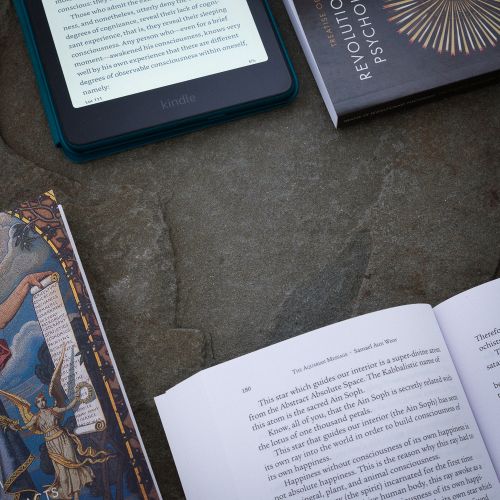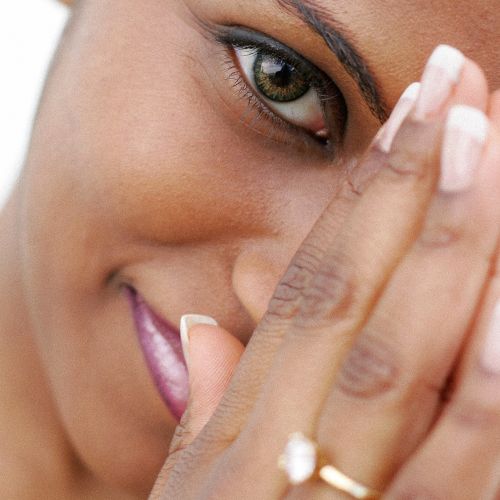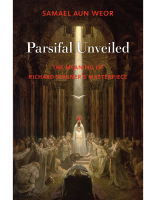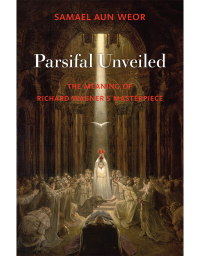The authentic Tantric doctrines of Vatsyayana’s Kamasutra and Kalyanamalla’s Anangaranga complement one another with Vajroli Yoga and Pancatattva.
The legitimate Hindustani Kamasutra has nothing to do with certain spurious, bastardized, adulterated editions, which, displaying the same title, profusely circulate everywhere, in all the western countries.
The mentioned classic book of the Hindu amatory art is divided into seven parts. The first part exposes conjointly the impulse of life and the arts and sciences which are of practical use in Sexual Magic.
Those women who have practiced Sexual Magic with a man are considered as instructors of the female beginners. The female disciple has to acquire seventy-four basic arts. Subsequently, among many of these arts are chanting, music, instrumentation, dance, tattooing, elaboration of beds with flower petals, musical execution with cups containing pure water, mineralogy, science of chemistry, organization of quail, ram, and rooster fights, and techniques of all literary works. The pupil is obliged to learn magic arts. Not only must she know how to prepare the diagrams and amorous philters of esoteric efficacy, but moreover, to instruct herself about sortilege and mantras.
In the second part of Kamasutra, the great Hindustani Master Vatsyayana wisely exposes an abundant esoteric teaching about the art of loving, especially occupying himself with something extraordinary, that is, the division of the types of women and men in accordance with the sizes of their sexual parts. He intelligently presents three types of men who are designated in accordance with their phallus, as:
- Hare
- Bull
- Stallion
In comparison to these males, the women are also classified in three types in accordance with the constitution of their yoni (sexual organ):
- Gazelle
- Mare
- Female Elephant
This differentiation in both sexes gives fundamentally nine amorous combinations, which come to remind us of the Ninth Sphere:
1. Excellent sexual pleasure:
- A. Hare with Gazelle
- B. Bull with Mare
- C. Stallion with Female Elephant
2. Unmatched sexual unions:
- A. Hare with Mare
- B. Hare with Female Elephant
- C. Bull with Gazelle
- D. Bull with Female Elephant
- E. Stallion with Mare
- F. Stallion with Gazelle
The nine possibilities of sexual union are subdivided into three types, in accordance with the size of the sexual organs:
- The proportion of the same size is indubitably the best.
- The relationship between large and small organs, between which the enjoyment of pleasure is most unfortunate.
- All of the other amorous relations can be classified as regular.
Unquestionably, the temperament of the consorts displays a great role in the sexual act. These are grouped in three types:
- Cold
- Mild
- Hot
Therefore, nine type of couplings are possible in the Ninth Sphere, namely:
A. Cold with Cold
B. Mild with Mild
C. Hot with Hot
Unmatched sexual unions:
A. Cold with Mild
B. Cold with Hot
C. Mild with Cold
D. Mild with Hot
E. Hot with Cold
F. Hot with Mild
Among the Hindus, the span of the sexual enjoyment, that is to say, the possibility of a long duration, is not based, for instance, in purely sensual, animal activity. Rather, it is considered a vital matter that expresses in the performed act a demonstration of a very developed and exquisite culture. The consort who is not truly educated about the most intimate sexual phenomena is considered deficient. This is what any man is, according to Rasamanjuri, who when in the act of love does not reflect upon what he should or should not do.
By all means it stands out in dazzling clarity that the prolongation of the sexual enjoyment is divided in three types:
1. Fast
2. Moderate
3. Slow
The secret of God’s happiness consists in His relation with Himself. From such a relation, in accordance with the law of philosophical analogies, comes every cosmic vehicle, every sexual junction. Therefore, the sexual act is a legitimate right of the human being. It is the happiness of God expressing itself through us.
Mohammed said,
“Coitus is an act even pleasing unto religion if, whenever it is performed, it is with the invocation to Allah and for reproduction with one’s own woman.”
The Koran states,
“Go and take for a wife a maiden whom you caress and who caresses you. Do not begin coitus without previously arousing each other with caresses.”
The Prophet emphasizes,
“Your women are your tilth, so come into your tillage how you choose; but do a previous good act for yourselves, and fear God, and know that one day you are going to meet Him.”
Accordingly, with the former thoughts, it is clear that the delightful coitus with the beloved is certainly a form of prayer. In those moments of supreme enjoyment we convert ourselves into collaborators with the creator Logos. We continue with the radiant and, in every instant, re-creative task of the maintenance of the universe within the mysterious bosom of the eternal Mother Space.
“Do as your creator does, as a powerful man in deeds and strength, who has consciousness in what he does. Thus, you will obtain double enjoyment, an increasing seminal liquor, and healthy and strong children.”
This is what Mohammed said,
“Ten graces bequests Allah to the man who grants his sympathy to the woman with caressing hands, twenty if he presses her against his heart; yet, if his amorous embrace is the authentic one, then he obtains from God thirty graces for every kiss.”
Kalyanamalla emphasizes the transcendental idea that the exact fulfillment of the code of love is much more difficult than the intellectual humanoid mistakenly thinks.
“The preliminary enjoyments are complicated in themselves. Therefore, this art must be employed in exact accordance with the precepts in order to arouse the woman’s passion, in the same way that a fire is kindled, for her yoni to become softer, more elastic, and suitable for the act of love.”
A wise author stated,
“Anangaranga confers great importance to both components of the couple in that they keep their everyday life from taking on a lukewarm quality, or letting weariness or satiety enter into their relationship, by consummating their love with spiritual absorption and total surrender. The method of intercourse, that is to say, the love-making position, is denominated asana [posture].”
Four modalities must be differentiated:
1. Uttana-banda
2. Tiryak
3. Upavishta
4. Utthita
Since the esoteric study of these four Tantric asanas has a complicated content with exclusively pedagogical goals, we will limit ourselves in this present book to specifically transcribing that sexual position named Upavishta.
Upavishta means “seated” position. Twelve sub-postures are given from this position:
- A. The especially favored position called Padmasana: the man sits on the bed or on a carpet with his legs crossed. He receives the woman on his legs and she envelops the body of the male with her legs in such a way that her two feet come to make contact with the masculine coccyx (see the graphic). Thus, the woman absorbs the phallus.
- B. Both seated, and during the delightful act, the woman lifts one of her legs with one hand.
- C. Man and woman entwine their hands behind each others necks.
- D. While the woman takes the feet of the man in her hands, he holds those of the woman.
- E. The man takes the legs of the woman with his arms; he lets them repose over the arc of his elbows and entwines his arms behind her neck.
- F. The turtle posture: both of them sit in such a way that their mouth, hands, and legs are mutually touching.
- G. Seated with the legs widely apart, the man enters her with his member, and presses her thighs between his.
- H. This posture is only executable by a very strong man with a very light woman: the man places the legs of the woman over his elbows, he then penetrates her with his member, thereafter he oscillates her from right to left.
- I. The same former posture, but the oscillation of the woman is effectuated back and forth.
The oriental Upavishta is marvelous; however, it is unquestionable that we, the Gnostics, are not exclusivists. It is obvious that in the western world many mystics prefer the following Asana:
- A. The woman lies down on the bed on her back, legs widely open, that is to say, opened from right to left, with a low pillow, or without it.
- B. The man places himself over the woman, between her legs, with the man’s face, chest, and belly making direct contact with the body of the female.
- C. Forehead against forehead, chest against chest, plexus against plexus: all of the corresponding astral centers superposing in order to permit an interchange of magnetic currents and thus, establishing a complete androgyne.
- D. Very slowly introduce the virile member into the vagina, avoiding violent actions. The movement of the phallus inside the uterus must be slow and delicate.
- E. The coitus must endure at least one hour.
- F. Withdraw from the woman before the spasm in order to avoid the ejaculation of the semen.
- G. The phallus must be withdrawn from within the uterus very slowly and with much delicacy.
When referring to Chinese medicine, Pierre Huard and Ming Wong state the following:
“Taoism still had an influence on medicine, as may be found in an anthology of Taoist works, the Sing-ming kuei-che (c. 1622). They divided the human body into three anatomical regions. The upper or cephalic region was the source of the spirits which dwelt in the body. The pillow of jade (yu-shen) is situated low in the back of the head. The so-called pillow bone is the occiput (shen-ku). The palace of ni-huan (from the Sanskrit ‘nirvana’) is situated in the brain, which is called the ‘sea of bone-marrow’ (suei-haz). It was the source of the seminal essences.
“The middle region was represented by the spine, which was not regarded as a functional column, but as a canal linking the cerebral cavities with the genitalia. It ended at a point called the ‘celestial column’ (t’ien-shu), at the hair line on the nape of the neck. It must not be confused with the acupuncture point of the same name.
“The lower region comprised the field of cinnabar (tan-t’ien) which will be referred to again later. It was the seat of genital activity represented by the two kidneys: the tiger’s fire (yang) on the left and the dragon’s fire (yin) on the right. Sexual union was symbolised by a couple: a young man leading the white tiger and a young woman riding the green dragon. Lead (the male element) and mercury (the female element) were to mingle. Immediately they were united, the pair cast their essence into a bronze cauldron, the symbol of sexual activity. But instead of being excreted and lost, the genital fluids, particularly the sperm (tsing), were capable of returning to the brain by the vertebral column, which thus offered a means of following once again the ‘path of life’. The basis of these Taoist sexual practices was coitus reservatus, during which the sperm which had descended from the encephalon [brain] to the bladder (but had not been ejaculated) returned to its source. This was called ‘returning the essence’ (huan-tsing). Whatever doubts we may have as to the reality of this return, it remains none the less true that the Taoists conceived a cerebral mastery of the basic instincts which kept the degree of genetic stimulation just below that of ejaculation. They thus brought to the sexual act a new technique and an end other than that of reproduction. Sexual practices played an important part in Taoism. Public, collective practices noted in the second century disappeared in the fifth. Private practices went on long enough for Ch’eng-tsu (twelfth century) to assign to them a section of his Tao-shu. Stripped of their religious content and adopted by doctors, they acquired a wide following under the banner of hygiene. In actual fact both Taoist and Buddhist monks observed rules of continence [that has its basis in sexual magic]. But the former regarded it as a form of detachment which was to lead them to deliverance, whereas the latter [in addition to their longing for attaining the Tao] remained chaste so as not to have their energies dissipated, in order to concentrate, to retain their essence and to live for a long time. It is possible that the Taoists were inspired, as in the case of their breathing exercises, by Indian tantrist works, of which certain were translated into Chinese during the Tang period and were known to Sun Szu-miao.
“The Pao-p’u-tzu contains a section entitled The Bedroom (eighteen chapters) which was printed in 1066 and reprinted in 1307, 1544 and 1604 by Chiao Shih-ning. Its data were reproduced on the basis of texts included in the Sui Annals by Tamba Yasuyori in his I-sin-fang (982-4) printed by Taki Genkin in 1854. This is a medical compendium in thirty chapters containing the ‘Secrets of the Bedroom’. It was republished by Yih To-huei (1864-1927) who reconstructed the lost texts, in particular the Ars Amatoria of Tun Hiuan.”
A great sage stated,
“By means of the practice of the Vajroli Mudra, the yogi makes his Shakti, that is to say the universal revealed sexual energy, in his own accord to flow, so that he will not be the only participant, but also his Lord.”
About the Viparitakarani he stated,
“This practice is the most excellent. It is the cause of the liberation for the yogi. This practice confers health to a yogi and grants him perfection.”
If we undress the Vajroli Mudra, if we tear the veil of Isis, then the naked truth remains, which is Sexual Magic, Sahaja Maithuna.
The esoteric Viparitakarani teaches in a clear and precise way how the Yogi can make his semen slowly arise by means of concentration, so that man and woman in complete copulation can reach the Vajroli.
“Om! Obeisance to the Goddess, who marvelously adorned resembles a dormant serpent in the svayambhu-linga. She enjoys the beloved one and others delights. She is captivated by the wine and radiates like a million light beams. She will be awakened (during sexual magic) by the air and fire, by the mantras YAM and DRAM and by the mantra HUM.”
Chant the former mantras in those precise moments in which the lingam-yoni are connected in the nuptial bed. Thus, this is how Devi Kundalini, the igneous serpent of our magical powers, will awaken.







